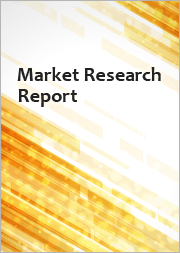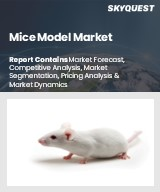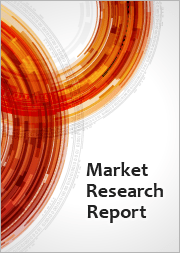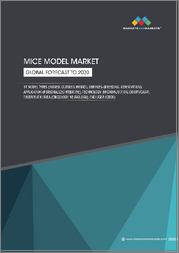
|
시장보고서
상품코드
1806191
마우스 모델 시장 : 모델 유형, 용도, 최종사용자별 - 세계 예측(2025-2030년)Mice Model Market by Model Type, Application, End User - Global Forecast 2025-2030 |
||||||
마우스 모델 시장은 2024년에는 16억 1,000만 달러로 평가되었습니다. 2025년에는 17억 4,000만 달러에 이르고, CAGR 8.38%로 성장하여 2030년에는 26억 1,000만 달러에 달할 것으로 예측됩니다.
| 주요 시장 통계 | |
|---|---|
| 기준 연도 : 2024년 | 16억 1,000만 달러 |
| 추정 연도 : 2025년 | 17억 4,000만 달러 |
| 예측 연도 : 2030년 | 26억 1,000만 달러 |
| CAGR(%) | 8.38% |
혁신적인 마우스 시스템이 어떻게 진화하여 현대 전임상 연구의 틀에서 필수적인 자산이 되었는지를 살펴봅니다.
생물의학 연구의 발전으로 마우스 계통의 역할은 단순한 실험 표본에서 현대의 치료법 발견을 지원하는 정교한 플랫폼으로 승화되었습니다. 지난 10년간 연구자들은 생쥐의 유전적 가소성과 생리적 연관성을 이용하여 인간의 질병을 점점 더 충실하게 모델링하고 있습니다. 그 결과, 이러한 모델은 분자경로 규명, 신약 타겟 검증, 안전성 프로파일 평가에 필수적인 도구가 되었습니다.
유전체 편집과 AI를 활용한 페노타이핑의 비약적 발전이 전임상 연구의 패러다임을 어떻게 재정의하고 있는가?
유전자 편집의 획기적인 발전, 번역적 정확성에 대한 요구, 고등 포유류 사용을 줄여야 한다는 윤리적 압력으로 인해 모델 마우스 연구의 상황은 크게 변화하고 있습니다. CRISPR-Cas9 및 관련 유전자 편집 플랫폼은 맞춤형 녹아웃 및 인간화 모델 제작의 민주화, 시간 단축 및 비용 절감을 가져왔습니다. 이러한 플랫폼은 현재 복잡한 인간 질병 시그니처를 재현하는 유전자 조작 마우스를 만들어내는 고도의 육종 전략과 공존하고 있습니다.
2025년 미국 무역 조치의 영향과 이것이 모델 조달 및 비즈니스 회복력에 미치는 중대한 영향에 대한 대응
2025년 미국의 관세 도입과 에스컬레이션은 마우스 모델 생태계에 도전과 재조정의 기회를 동시에 가져왔습니다. 수입 과학 소모품 및 자체 육종 재고에 대한 관세로 인해 모델 제작 비용이 상승하여 많은 조직이 공급망과 공급업체 포트폴리오를 재검토해야 하는 상황에 처해 있습니다. 연구기관이나 의약품 개발업무 위탁기관에서는 주문의 일원화, 장기공급계약 협상, 지역에 기반을 둔 번식시설 투자 등으로 경제적 부담을 줄이려고 노력하고 있습니다.
모델 유형의 복잡성과 용도 중심의 요구 사항이 어떻게 수렴하여 다양한 연구 경로를 형성하는지를 보여줍니다.
다양한 연구 필요성과 자금 조달의 우선순위는 마우스 모델 시장을 특정 실험 요구에 따라 명확한 카테고리로 세분화하는 원동력이 되고 있습니다. 근친교배 마우스 계통은 기초 연구에 이상적인 재현성 있는 유전적 배경을 제공하고, 근친교배 모델은 인간 개체군을 반영하여 독성 평가를 지원하는 불균일성을 도입합니다. 유전자 조작 측면에서 조건부 녹아웃은 시간적, 조직 특이적 제어를 제공하고, 형질전환 계통은 경로 분석을 위해 외래 유전자를 발현시키고, 녹아웃 모델은 완전한 유전자 제거를 통해 유전자 기능을 밝히고, 인간화 시스템은 인간의 면역 동역학을 재현합니다.
마우스 연구 플랫폼의 차별화된 채택을 촉진하는 지역 연구 생태계와 자금 조달의 우선순위 평가.
지역별 역학관계는 북미, 남미, 유럽, 중동 및 아프리카, 아시아태평양의 연구 투자, 인프라, 공동연구 네트워크의 미묘한 패턴을 보여줍니다. 미국 대륙에서는 탄탄한 자금 생태계와 집중된 생명공학 허브가 수직적으로 통합된 공급망을 육성하여 고급 마우스 모델의 신속한 채택을 가능하게 합니다. 북미의 연구 컨소시엄과 정부 이니셔티브는 기술 이전을 가속화하는 민관 파트너십을 촉진하고 있습니다.
마우스 모델 혁신을 주도하는 기술 리더십과 전략적 제휴로 정의되는 경쟁 리더십 생태계를 매핑하는 기술 리더십과 전략적 제휴별 매핑
경쟁 환경에는 전문 실험동물 사육시설 운영자, 유전공학의 선구자, 기술 통합, 광범위한 포트폴리오, 세계 진출로 차별화를 꾀하는 종합 서비스 제공업체가 있습니다. 주요 실험동물 공급업체들은 희귀한 녹아웃 계통과 인간화 계통을 포함하는 유전자 아카이브를 확장하고 있으며, 신속한 확장성과 맞춤형 콜로니 관리를 제공하는 위탁 번식 서비스를 통해 이를 보완하고 있습니다.
이해관계자들이 회복탄력성을 강화하고 전임상 모델 혁신을 가속화하기 위한 전략적 방향을 제시합니다.
업계 리더들은 무역 관련 위험을 줄이고 지속적인 공급을 보장하기 위해 지역 기반 번식 인프라에 대한 투자를 우선시해야 합니다. 확장 가능한 역량을 갖춘 지역 동물 사육 허브를 구축함으로써 리드 타임을 단축하고 긴급한 연구 프로젝트에 대한 대응력을 높일 수 있습니다. 한편, 유전자 편집 전문가와의 협업을 촉진함으로써 치료 파이프라인의 고유한 표적에 맞는 맞춤형 모델 개발을 효율화할 수 있습니다.
1차 조사와 종합적인 2차 데이터 검증을 활용한 강력한 하이브리드 조사 프레임워크에 대해 자세히 알아보기
우리의 분석은 1차 및 2차 조사 데이터 수집, 엄격한 검증, 삼각측량으로 구성된 다층적 조사방법을 통합한 것입니다. 먼저, 2차 정보원으로서, 피어리뷰 문헌, 특허 데이터베이스, 규제 당국 신고, 업계 백서 등을 조사하여 기초적인 맥락을 확립하고, 새로운 동향을 파악했습니다.
마우스 연구 모델의 미래를 형성하는 공동 혁신과 전략적 선견지명에 대한 통찰력 통합
마우스 모델은 과학적 혁신, 윤리적 고려, 상업적 요청의 접점에 위치하고 있습니다. 유전자 편집, 디지털 페노타이핑, 지역 투자 전략 등 진화하는 상황은 창조적 파괴와 기회로 특징지어지는 유동적인 시장을 부각시키고 있습니다. 공급망 취약점을 적극적으로 해결하고 새로운 기술을 채택하는 이해관계자들은 다음 단계의 전임상 돌파구를 선도할 수 있는 좋은 위치에 서게 될 것입니다.
목차
제1장 서문
제2장 조사 방법
제3장 주요 요약
제4장 시장 개요
제5장 시장 역학
제6장 시장 인사이트
- Porter's Five Forces 분석
- PESTEL 분석
제7장 미국 관세의 누적 영향 2025
제8장 마우스 모델 시장 : 모델 유형별
- 유전자 재조합 마우스 모델
- 조건부 녹아웃 모델
- 인간화 마우스 모델
- 녹아웃 모델
- 변압기 적합 모델
- 근교계 마우스 모델
- 비근교계 마우스 모델
제9장 마우스 모델 시장 : 용도별
- 행동 연구
- 심혈관 질환
- Drug Discovery 및 독성학
- 유전성 질환 조사
- 면역학
- 감염증
- 대사장애
- 신경학 및 신경 퇴행성 질환
- 종양 연구
제10장 마우스 모델 시장 : 최종사용자별
- 학술연구기관
- 수탁연구기관(CRO)
- 병원 및 진단센터
- 제약 기업 및 바이오테크놀러지 기업
제11장 아메리카의 마우스 모델 시장
- 미국
- 캐나다
- 멕시코
- 브라질
- 아르헨티나
제12장 유럽, 중동 및 아프리카의 마우스 모델 시장
- 영국
- 독일
- 프랑스
- 러시아
- 이탈리아
- 스페인
- 아랍에미리트(UAE)
- 사우디아라비아
- 남아프리카공화국
- 덴마크
- 네덜란드
- 카타르
- 핀란드
- 스웨덴
- 나이지리아
- 이집트
- 튀르키예
- 이스라엘
- 노르웨이
- 폴란드
- 스위스
제13장 아시아태평양의 마우스 모델 시장
- 중국
- 인도
- 일본
- 호주
- 한국
- 인도네시아
- 태국
- 필리핀
- 말레이시아
- 싱가포르
- 베트남
- 대만
제14장 경쟁 구도
- 시장 점유율 분석, 2024
- FPNV 포지셔닝 매트릭스, 2024
- 경쟁 분석
- Applied StemCell, Inc.
- Aragen Life Sciences Ltd.
- Biocytogen Boston Corporation
- Charles River Laboratories International, Inc.
- Creative Biolabs
- Crown Bioscience by JSR Life Sciences, LLC
- Cyagen US Inc. by PolyGene AG
- Envigo by Inotiv, Inc.
- GenOway
- Harbour BioMed
- inGenious Targeting Laboratory, Inc.
- Janvier Labs
- Marshall BioResources
- MD Biosciences
- Mirimus, Inc.
- Ozgene Pty Ltd.
- PhoenixBio Co., Ltd.
- Shanghai Model Organisms Center, Inc.
- Taconic Biosciences, Inc.
- The Jackson Laboratory
- TransCure bioServices
- Translational Drug Development, LLC
- Urosphere SAS
- XenOPAT SL by Bellvitge Biomedical Research Institute
제15장 리서치 AI
제16장 리서치 통계
제17장 리서치 컨택트
제18장 리서치 기사
제19장 부록
LSH 25.09.17The Mice Model Market was valued at USD 1.61 billion in 2024 and is projected to grow to USD 1.74 billion in 2025, with a CAGR of 8.38%, reaching USD 2.61 billion by 2030.
| KEY MARKET STATISTICS | |
|---|---|
| Base Year [2024] | USD 1.61 billion |
| Estimated Year [2025] | USD 1.74 billion |
| Forecast Year [2030] | USD 2.61 billion |
| CAGR (%) | 8.38% |
Exploring how innovative murine systems have evolved to become indispensable assets in contemporary preclinical research frameworks
Advancements in biomedical research have elevated the role of murine systems from simple laboratory specimens to sophisticated platforms that underpin modern therapeutic discovery. Over the past decade, researchers have harnessed the genetic malleability and physiological relevance of mice to model human diseases with ever-increasing fidelity. As a result, these models have become indispensable tools for elucidating molecular pathways, validating drug targets, and assessing safety profiles.
In parallel, the proliferation of novel genetic engineering technologies has expanded the repertoire of available strains, enabling conditional gene expression, humanized immune responses, and tissue-specific knockouts. This convergence of technical innovation and unmet clinical needs has accelerated preclinical workflows, reshaping research priorities across academia, industry, and clinical settings. Consequently, an understanding of the current mice model landscape is essential for stakeholders seeking to navigate competitive pressures and align their research strategies with emergent trends.
How breakthroughs in genome editing and AI-powered phenotyping are redefining the preclinical research paradigm
The landscape of mice model research is undergoing transformative shifts driven by breakthroughs in genome editing, demand for translational accuracy, and ethical pressures to reduce higher-order mammalian use. CRISPR-Cas9 and related gene-editing platforms have democratized the creation of custom knockouts and humanized models, accelerating timelines and lowering costs. These platforms now coexist with advanced breeding strategies to yield genetically engineered mice that replicate complex human disease signatures.
Meanwhile, the integration of high-throughput phenotyping and in vivo imaging has enhanced the resolution at which researchers monitor disease progression and therapeutic efficacy. Artificial intelligence and machine learning algorithms have begun to sift through enormous data sets generated in these studies, offering predictive insights and facilitating the selection of optimal model types.
Ethical considerations and regulatory scrutiny have further influenced the market, prompting the implementation of rigorous welfare standards and incentivizing the development of alternative assays. As stakeholders navigate these dynamic forces, they must remain agile to leverage innovations that improve translational relevance and operational efficiency.
Navigating the ramifications of US trade measures in 2025 and their profound implications on model sourcing and operational resilience
The introduction and escalation of United States tariffs in 2025 have introduced both challenges and recalibration opportunities for the mice model ecosystem. Tariffs on imported scientific consumables and proprietary breeding stock have elevated costs for model generation, compelling many organizations to reassess their supply chains and vendor portfolios. Research institutions and Contract Research Organizations have sought to mitigate financial burdens by consolidating orders, negotiating long-term supply agreements, and investing in localized breeding facilities.
Despite these headwinds, the tariff environment has also galvanized domestic production capacity, as vendors expand in-country vivaria and streamline licensing processes to meet shifting demand. Consequently, collaborative networks have emerged between academic centers and biotechnology firms to share breeding resources and expertise, fostering resilience against trade uncertainties. Companies that adapt by diversifying sourcing strategies and embracing vertical integration stand to enhance supply security while maintaining rigorous standards of reproducibility.
Uncovering how model type intricacies and application-driven requirements converge to shape distinct research pathways
Diverse research imperatives and funding priorities have driven the segmentation of the mice model market into distinct categories that align with specific experimental needs. Inbred mice strains provide reproducible genetic backgrounds ideal for foundational studies, while outbred models introduce heterogeneity that mirrors human populations and supports toxicology assessments. On the genetically engineered front, conditional knockouts offer temporal and tissue-specific control, transgenic lines express exogenous genes for pathway analysis, knockout models elucidate gene function through full gene removal, and humanized systems recapitulate human immune dynamics.
Application segmentation reveals a broad spectrum of disease and therapeutic domains. Behavioral studies leverage specialized strains to probe neurological function, whereas cardiovascular research benefits from hypertensive and atherosclerotic models. Drug discovery and toxicology demand robust systems for early safety screening, and genetic disease research relies on congenital and metabolic disorder models. Immunology experiments are underpinned by humanized mice, infectious disease research exploits susceptibility variants, neurodegenerative inquiries utilize Alzheimer's and Parkinson's transgenics, and oncology investigations draw upon xenograft and syngeneic tumor systems.
End users range from academic and research institutions driving fundamental science to contract research organizations performing outsourced studies. Hospitals and diagnostic centers integrate preclinical findings into translational initiatives, while pharmaceutical and biotechnology companies depend on these models to advance pipelines from candidate identification through pre-IND safety assessment. Each segment presents unique requirements, procurement cycles, and validation standards that inform tailored service offerings.
Evaluating regional research ecosystems and funding priorities that drive differentiated adoption of murine research platforms
Regional dynamics reveal nuanced patterns in research investment, infrastructure, and collaborative networks across the Americas, Europe, Middle East & Africa, and Asia-Pacific. In the Americas, robust funding ecosystems and concentrated biotechnology hubs have cultivated vertically integrated supply chains, enabling rapid adoption of advanced mouse models. North American research consortia and government initiatives foster public-private partnerships that accelerate technology translation.
Across Europe, Middle East & Africa, stringent regulatory frameworks have elevated animal welfare standards, prompting synchronized adoption of refinement techniques and alternative validation methods. Strong academic clusters in Western Europe collaborate with biotech startups to co-develop bespoke strains, while emerging markets in the Middle East and Africa focus on capacity building and training to broaden regional expertise.
The Asia-Pacific region exhibits explosive growth fueled by rising research expenditure, expanding contract research organizations, and government incentives aimed at biotech innovation. China, Japan, and South Korea lead investment in state-of-the-art vivarium infrastructure, whereas Southeast Asian nations emphasize cross-border partnerships and talent development to meet escalating demand for translational models.
Mapping the competitive ecosystem defined by technological leadership and strategic alliances driving murine model innovation
The competitive landscape features specialized vivarium operators, genetic engineering pioneers, and comprehensive service providers that differentiate through technology integration, portfolio breadth, and global reach. Leading laboratory animal suppliers have expanded their genetic archives to encompass rare knockout and humanized lines, complemented by contract breeding services that offer rapid scalability and customized colony management.
Innovators of genome-editing tools have forged partnerships with pharmaceutical giants to co-develop disease models aligned with pipeline priorities, while full-service contract research organizations bundle model provision with in vivo efficacy and toxicological evaluation. Strategic collaborations between academic institutions and commercial entities have accelerated the commercial deployment of new strains, deepening the bench-to-bedside integration.
Companies that invest in digital platforms for colony management and integrate imaging-based phenotyping services have gained a competitive edge by unlocking data-rich insights and fostering reproducibility. As intellectual property considerations intensify, players with robust patent portfolios and licensing frameworks command premium positioning, particularly for next-generation humanized and conditional knockout models.
Outlined strategic directives empowering stakeholders to enhance resilience and accelerate preclinical model innovation
Industry leaders should prioritize investments in localized breeding infrastructure to mitigate trade-related risks and ensure uninterrupted supply. Establishing regional vivarium hubs with scalable capacity will reduce lead times and enhance responsiveness to emergent research projects. Meanwhile, fostering collaborations with genome-editing specialists can streamline the development of bespoke models that match therapeutic pipelines' unique targets.
Organizations must also capitalize on digitalization by adopting cloud-based colony management systems and AI-driven phenotyping platforms. These tools not only bolster data integrity but also accelerate decision-making processes through predictive analytics. Concurrently, proactive engagement with regulatory authorities and ethics committees will help organizations anticipate evolving welfare standards and streamline model approval pathways.
Finally, corporate research divisions, academic centers, and contract organizations should coalesce around consortia that share best practices, breeding resources, and phenotypic databases. Such collaborative networks will dilute operational costs, spur innovation, and cultivate a resilient infrastructure capable of adapting to geopolitical and technological shifts.
Detailing a robust hybrid research framework leveraging primary interviews and comprehensive secondary data validation
Our analysis integrates a multi-layered research methodology composed of primary and secondary data collection, rigorous validation, and triangulation. Initially, secondary sources were examined, encompassing peer-reviewed literature, patent databases, regulatory filings, and industry white papers to establish foundational context and identify emerging trends.
Subsequently, in-depth interviews with key opinion leaders across academia, contract research organizations, and biotechnology firms provided qualitative insights into operational challenges, adoption drivers, and innovation roadblocks. Data gleaned from these discussions underwent cross-verification against commercial intelligence platforms, vendor catalogs, and technical specifications to ensure consistency.
Quantitative data points were subjected to triangulation through comparative analysis of company disclosures, public grant databases, and import-export records. This multi-pronged approach enabled a balanced perspective that accounts for both macro-level influences and micro-level decision criteria. Findings were then synthesized into coherent narratives that reflect current market realities, future inflection points, and actionable intelligence.
Synthesizing insights on collaborative innovation and strategic foresight shaping the future of murine research models
Mice models stand at the confluence of scientific innovation, ethical considerations, and commercial imperatives. The evolving landscape of genome editing, digital phenotyping, and regional investment strategies underscores a market in flux-one characterized by both disruption and opportunity. Stakeholders who proactively address supply-chain vulnerabilities and adopt emerging technologies will be well-positioned to lead the next wave of preclinical breakthroughs.
The cumulative impact of trade policies, shifting funding landscapes, and rising demand for translational fidelity necessitates an agile approach to portfolio planning and infrastructure development. By aligning operational capabilities with cutting-edge scientific advances and regulatory requirements, organizations can ensure sustained relevance and competitive differentiation.
In sum, the trajectory of mice model research hinges on collaboration, innovation, and strategic foresight. Those who master these imperatives will unlock new avenues for therapeutic discovery, augment their research efficiency, and ultimately contribute to meaningful advancements in human health.
Table of Contents
1. Preface
- 1.1. Objectives of the Study
- 1.2. Market Segmentation & Coverage
- 1.3. Years Considered for the Study
- 1.4. Currency & Pricing
- 1.5. Language
- 1.6. Stakeholders
2. Research Methodology
- 2.1. Define: Research Objective
- 2.2. Determine: Research Design
- 2.3. Prepare: Research Instrument
- 2.4. Collect: Data Source
- 2.5. Analyze: Data Interpretation
- 2.6. Formulate: Data Verification
- 2.7. Publish: Research Report
- 2.8. Repeat: Report Update
3. Executive Summary
4. Market Overview
- 4.1. Introduction
- 4.2. Market Sizing & Forecasting
5. Market Dynamics
- 5.1. Expansion of humanized mouse models to improve immuno-oncology therapeutic testing and translational accuracy
- 5.2. Adoption of 3D bioprinted mouse organoids to enhance preclinical drug safety and toxicity studies
- 5.3. Growth of microbiome-modified mouse models to investigate gut-brain axis interactions in neurodegenerative research
- 5.4. Rising demand for aged mouse models to better mirror geriatric disease phenotypes in cardiovascular research
- 5.5. Utilization of high-throughput phenotyping platforms for large-scale mouse genetic screening in precision medicine
- 5.6. Integration of artificial intelligence-driven image analysis in mouse behavioral assays for neuropsychiatric drug discovery
- 5.7. Development of ultra-flexible custom breeding programs for transgenic and knockout mouse lines to meet specialized research needs
6. Market Insights
- 6.1. Porter's Five Forces Analysis
- 6.2. PESTLE Analysis
7. Cumulative Impact of United States Tariffs 2025
8. Mice Model Market, by Model Type
- 8.1. Introduction
- 8.2. Genetically Engineered Mice Models
- 8.2.1. Conditional Knockout Models
- 8.2.2. Humanized Mice Models
- 8.2.3. Knockout Models
- 8.2.4. Transgenic Models
- 8.3. Inbred Mice Models
- 8.4. Outbred Mice Models
9. Mice Model Market, by Application
- 9.1. Introduction
- 9.2. Behavioral Studies
- 9.3. Cardiovascular Diseases
- 9.4. Drug Discovery & Toxicology
- 9.5. Genetic Disease Research
- 9.6. Immunology
- 9.7. Infectious Diseases
- 9.8. Metabolic Disorders
- 9.9. Neurology & Neurodegenerative Diseases
- 9.10. Oncology Research
10. Mice Model Market, by End User
- 10.1. Introduction
- 10.2. Academic & Research Institutions
- 10.3. Contract Research Organizations (CROs)
- 10.4. Hospitals & Diagnostic Centers
- 10.5. Pharmaceutical & Biotechnology Companies
11. Americas Mice Model Market
- 11.1. Introduction
- 11.2. United States
- 11.3. Canada
- 11.4. Mexico
- 11.5. Brazil
- 11.6. Argentina
12. Europe, Middle East & Africa Mice Model Market
- 12.1. Introduction
- 12.2. United Kingdom
- 12.3. Germany
- 12.4. France
- 12.5. Russia
- 12.6. Italy
- 12.7. Spain
- 12.8. United Arab Emirates
- 12.9. Saudi Arabia
- 12.10. South Africa
- 12.11. Denmark
- 12.12. Netherlands
- 12.13. Qatar
- 12.14. Finland
- 12.15. Sweden
- 12.16. Nigeria
- 12.17. Egypt
- 12.18. Turkey
- 12.19. Israel
- 12.20. Norway
- 12.21. Poland
- 12.22. Switzerland
13. Asia-Pacific Mice Model Market
- 13.1. Introduction
- 13.2. China
- 13.3. India
- 13.4. Japan
- 13.5. Australia
- 13.6. South Korea
- 13.7. Indonesia
- 13.8. Thailand
- 13.9. Philippines
- 13.10. Malaysia
- 13.11. Singapore
- 13.12. Vietnam
- 13.13. Taiwan
14. Competitive Landscape
- 14.1. Market Share Analysis, 2024
- 14.2. FPNV Positioning Matrix, 2024
- 14.3. Competitive Analysis
- 14.3.1. Applied StemCell, Inc.
- 14.3.2. Aragen Life Sciences Ltd.
- 14.3.3. Biocytogen Boston Corporation
- 14.3.4. Charles River Laboratories International, Inc.
- 14.3.5. Creative Biolabs
- 14.3.6. Crown Bioscience by JSR Life Sciences, LLC
- 14.3.7. Cyagen US Inc. by PolyGene AG
- 14.3.8. Envigo by Inotiv, Inc.
- 14.3.9. GenOway
- 14.3.10. Harbour BioMed
- 14.3.11. inGenious Targeting Laboratory, Inc.
- 14.3.12. Janvier Labs
- 14.3.13. Marshall BioResources
- 14.3.14. MD Biosciences
- 14.3.15. Mirimus, Inc.
- 14.3.16. Ozgene Pty Ltd.
- 14.3.17. PhoenixBio Co., Ltd.
- 14.3.18. Shanghai Model Organisms Center, Inc.
- 14.3.19. Taconic Biosciences, Inc.
- 14.3.20. The Jackson Laboratory
- 14.3.21. TransCure bioServices
- 14.3.22. Translational Drug Development, LLC
- 14.3.23. Urosphere SAS
- 14.3.24. XenOPAT SL by Bellvitge Biomedical Research Institute






